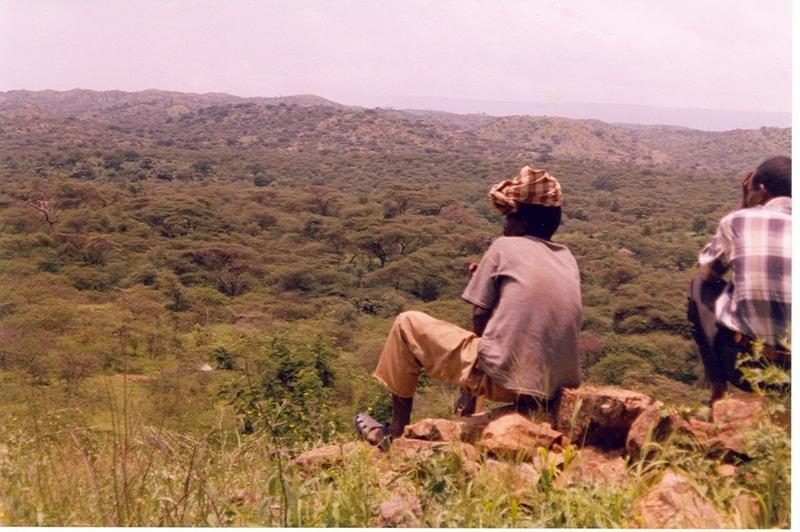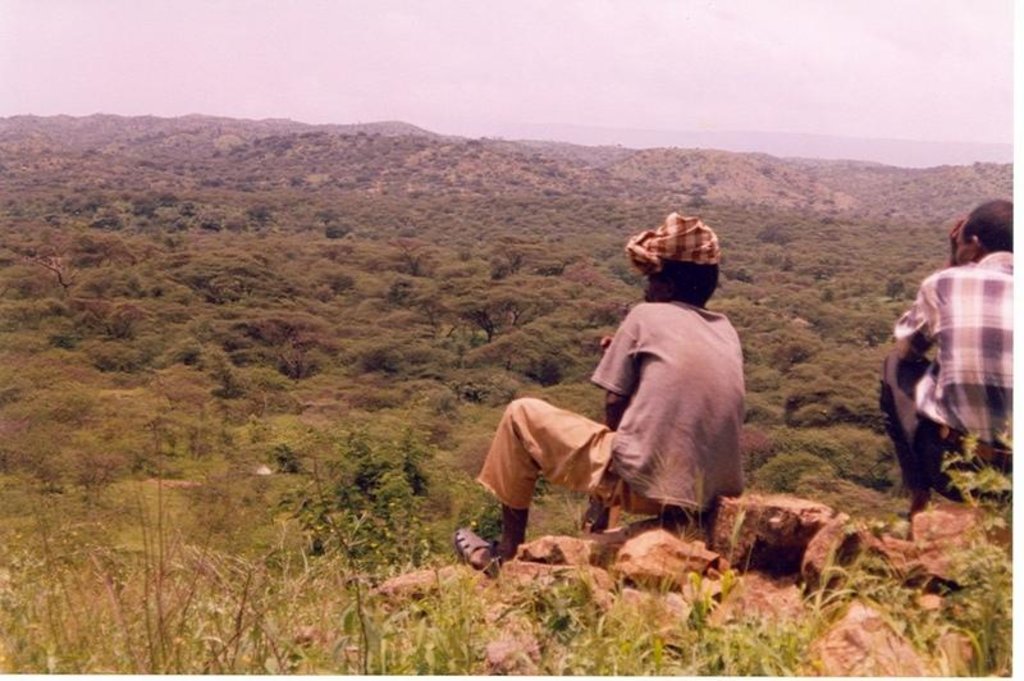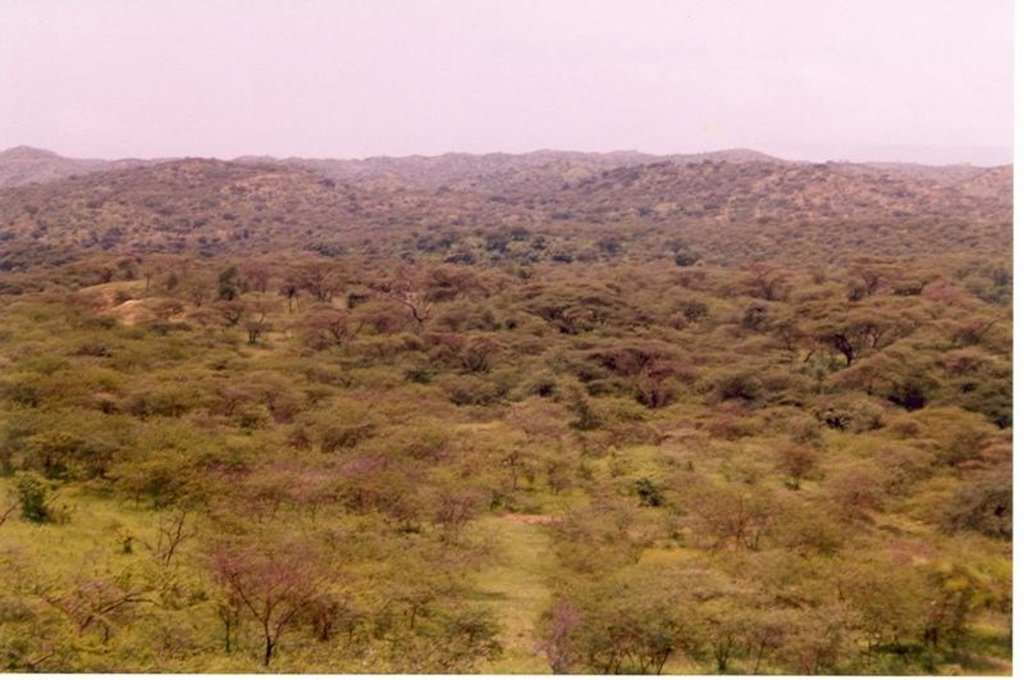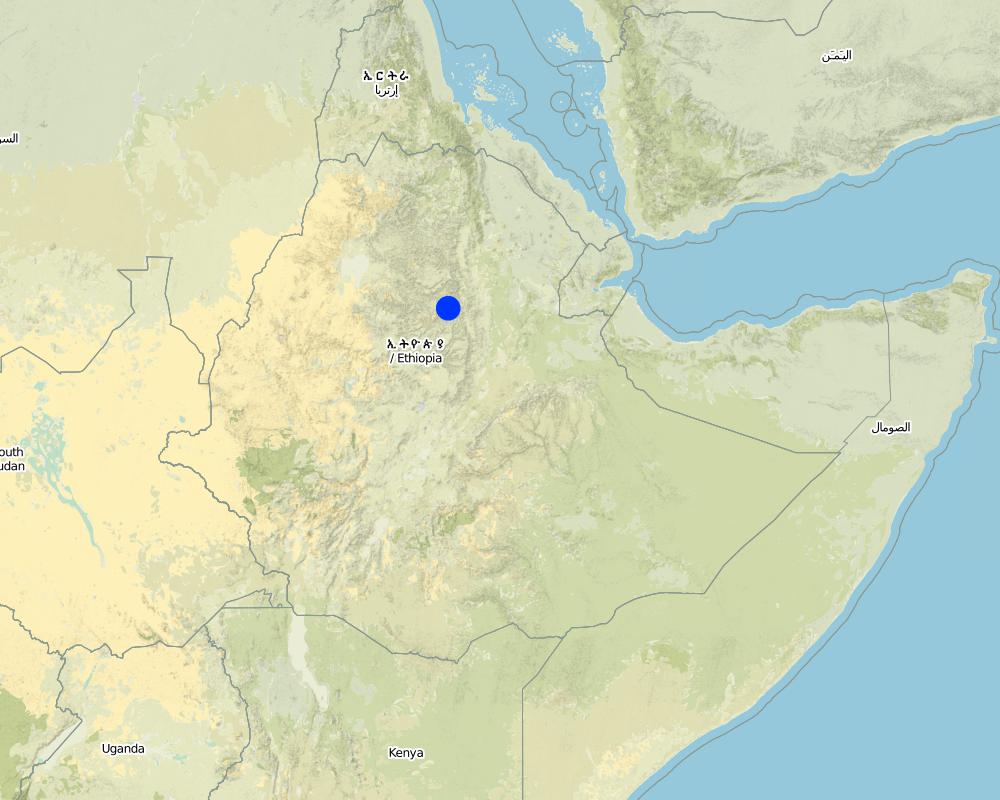Area closure [埃塞俄比亚]
- 创建:
- 更新:
- 编制者: Unknown User
- 编辑者: –
- 审查者: Fabian Ottiger, Alexandra Gavilano
Bota Klela (Tigrigna)
technologies_1414 - 埃塞俄比亚
查看章节
全部展开 全部收起1. 一般信息
1.3 关于使用通过WOCAT记录的数据的条件
编制者和关键资源人员接受有关使用通过WOCAT记录数据的条件。:
是
1.5 参考关于SLM方法(使用WOCAT记录的SLM方法)的调查问卷

Project (LLPPA) [埃塞俄比亚]
It is a local level participatory planning approach.
- 编制者: Philippe Zahner
2. SLM技术的说明
2.1 技术简介
技术定义:
Closure of degraded land is made on land that has lost vegetation cover, has low soil fertility . To speed up the regeneration process applying some SWC activities and enrichment plantation will be necessary.
2.2 技术的详细说明
说明:
The degraded land is closed from human and animal interfrances for at least 3-5 years. Inorder to enhance the rehabilitation rate of the degraded land SWC activities, such as terracing, enrichment plantation and oversowing of grass species is considered. These practices enhances growth of natural vegetation and enriches biodiversity.
2.3 技术照片
2.5 已应用该技术的、本评估所涵盖的国家/地区/地点
国家:
埃塞俄比亚
区域/州/省:
Tigray
有关地点的进一步说明:
Ahferom
具体说明该技术的分布:
- 均匀地分布在一个区域
如果不知道精确的区域,请注明大致覆盖的区域:
- 10-100 平方千米
注释:
Total area covered by the SLM Technology is 54.6 km2.
The bush land are closed and in some areas SWC activities were made and enrichment plantation has been done.
Map
×2.6 实施日期
如果不知道确切的年份,请说明大概的日期:
- 50多年前(传统)
2.7 技术介绍
详细说明该技术是如何引入的:
- 通过项目/外部干预
注释(项目类型等):
From churches and other religious areas
3. SLM技术的分类
3.2 应用该技术的当前土地利用类型

农田
- 一年一作
- 多年一作(非木材)
- 乔木与灌木的种植
- Rhodes grass, local grasses
- Acacia saligna, grevellia, schinesmolle
每年的生长季节数:
- 1
具体说明:
Longest growing period in days: 180Longest growing period from month to month: May - Oct

牧场
- free grazing

森林/林地
产品和服务:
- 木材
- 水果和坚果
- 其它森林产品
- 自然保持/保护
注释:
Major land use problems (compiler’s opinion): Soil erosion, deforestation, degradation, loss of biodiversity, reduction in land productivity
Major land use problems (land users’ perception): Low productivity and decline of soil fertility.
Other grazingland: free grazing
Other type of forest: area rehabilitation: lack of awarness
Problems / comments regarding forest use: In the closed forests enrichment plantation is undertaken. Individual woodlots are planted at homesteads. Currently individuals considered land less, poor and women are given land from the hillsides to plant and enclose them. The purpose is to enable individuals to generate income from it.
3.4 供水
该技术所应用土地的供水:
- 雨养
注释:
Water supply: Also mixed rainfed - irrigated
3.5 该技术所属的SLM组
- 区域封闭(停止使用,支持恢复)
3.6 包含该技术的可持续土地管理措施
3.7 该技术强调的主要土地退化类型

土壤水蚀
- Wt:表土流失/地表侵蚀
- Wg:冲沟侵蚀/沟蚀

化学性土壤退化
- Cn:肥力下降和有机质含量下降(非侵蚀所致)

物理性土壤退化
- Pu:由于其他活动而导致生物生产功能的丧失

水质恶化
- Ha:干旱化
注释:
Main type of degradation addressed: Wt: loss of topsoil / surface erosion, Wg: gully erosion / gullying
Secondary types of degradation addressed: Cn: fertility decline and reduced organic matter content, Pu: loss of bio-productive function due to other activities, Ha: aridification
Main causes of degradation: over-exploitation of vegetation for domestic use (wood cutting), overgrazing (trampling, degraded cover-plant), education, access to knowledge and support services (lack of knowledge)
Secondary causes of degradation: other human induced causes (specify) (agricultural causes), Heavy / extreme rainfall (intensity/amounts) (heavy rainfalls), poverty / wealth (lack of captial), land policy
3.8 防止、减少或恢复土地退化
具体数量名该技术与土地退化有关的目标:
- 防止土地退化
- 减少土地退化
注释:
Also: rehabilitation / reclamation of denuded land
4. 技术规范、实施活动、投入和成本
4.1 该技术的技术图纸
技术规范(与技术图纸相关):
Technical knowledge required for field staff / advisors: high
Technical knowledge required for land users: moderate
Main technical functions: control of raindrop splash, control of dispersed runoff: impede / retard, control of concentrated runoff: retain / trap, increase of surface roughness, increase of infiltration, increase / maintain water stored in soil, water harvesting / increase water supply, water spreading, improvement of soil structure
Secondary technical functions: control of dispersed runoff: retain / trap, reduction of slope angle, reduction of slope length, increase in organic matter, increase in soil fertility
Vegetative measure: Vegetative material: T : trees / shrubs, G : grass
Number of plants per (ha): 500
Vegetative measure: Vegetative material: T : trees / shrubs, G : grass
Vegetative measure: Vegetative material: T : trees / shrubs, G : grass
Vegetative measure: Vegetative material: T : trees / shrubs, G : grass
Trees/ shrubs species: Acacia saligna, grevellia, schinesmolle
Grass species: Rhodes grass, local grasses
Terrace: bench level
Vertical interval between structures (m): 2
Spacing between structures (m): 5-8
Height of bunds/banks/others (m): 0.5-0.75
Width of bunds/banks/others (m): 1
Length of bunds/banks/others (m): 300
Slope (which determines the spacing indicated above): 30%
Lateral gradient along the structure: 0%
Vegetation is used for stabilisation of structures.
Change of land use practices / intensity level: area closure
4.2 有关投入和成本计算的一般信息
其它/国家货币(具体说明):
Birr
如相关,注明美元与当地货币的汇率(例如1美元=79.9巴西雷亚尔):1美元=:
8.0
注明雇用劳工的每日平均工资成本:
0.88
4.3 技术建立活动
| 活动 | 时间(季度) | |
|---|---|---|
| 1. | Seedling Production | Januray-June |
| 2. | Pitting | May |
| 3. | Planting | Jully |
| 4. | Layout and survey | September |
| 5. | Stone collection | December-may |
| 6. | Foundation excavation and construction | December-may |
| 7. | Awarness creation and site selection | January |
| 8. | Area closed | |
| 9. | Site guard | throughout the year |
4.4 技术建立所需要的费用和投入
| 对投入进行具体说明 | 单位 | 数量 | 单位成本 | 每项投入的总成本 | 土地使用者承担的成本% | |
|---|---|---|---|---|---|---|
| 劳动力 | Labour | ha | 1.0 | 154.0 | 154.0 | 10.0 |
| 设备 | Tools | ha | 1.0 | 6.5 | 6.5 | 100.0 |
| 植物材料 | Seeds | ha | 1.0 | 2.0 | 2.0 | |
| 其它 | Person days | ha | 1.0 | 28.0 | 28.0 | 100.0 |
| 技术建立所需总成本 | 190.5 | |||||
| 技术建立总成本,美元 | 23.81 | |||||
注释:
Duration of establishment phase: 120 month(s)
4.5 维护/经常性活动
| 活动 | 时间/频率 | |
|---|---|---|
| 1. | Planting | Jully /yearly |
| 2. | Weeding | end of August /once |
| 3. | Stone collection | July-august/annual |
| 4. | Construction | July-august/annual |
| 5. | Enrichment plantation | July / annual |
4.6 维护/经常性活动所需要的费用和投入(每年)
| 对投入进行具体说明 | 单位 | 数量 | 单位成本 | 每项投入的总成本 | 土地使用者承担的成本% | |
|---|---|---|---|---|---|---|
| 劳动力 | Labour | ha | 1.0 | 15.0 | 15.0 | 100.0 |
| 技术维护所需总成本 | 15.0 | |||||
| 技术维护总成本,美元 | 1.88 | |||||
注释:
length of structure, site guard/ha, number of seedlings
4.7 影响成本的最重要因素
描述影响成本的最决定性因素:
labour, slope
5. 自然和人文环境
5.1 气候
年降雨量
- < 250毫米
- 251-500毫米
- 501-750毫米
- 751-1,000毫米
- 1,001-1,500毫米
- 1,501-2,000毫米
- 2,001-3,000毫米
- 3,001-4,000毫米
- > 4,000毫米
指定年平均降雨量(若已知),单位为mm:
650.00
农业气候带
- 半湿润
- 半干旱
5.2 地形
平均坡度:
- 水平(0-2%)
- 缓降(3-5%)
- 平缓(6-10%)
- 滚坡(11-15%)
- 崎岖(16-30%)
- 陡峭(31-60%)
- 非常陡峭(>60%)
地形:
- 高原/平原
- 山脊
- 山坡
- 山地斜坡
- 麓坡
- 谷底
垂直分布带:
- 0-100 m a.s.l.
- 101-500 m a.s.l.
- 501-1,000 m a.s.l.
- 1,001-1,500 m a.s.l.
- 1,501-2,000 m a.s.l.
- 2,001-2,500 m a.s.l.
- 2,501-3,000 m a.s.l.
- 3,001-4,000 m a.s.l.
- > 4,000 m a.s.l.
关于地形的注释和进一步规范:
Altitudinal zone: 1000-2500 m a.s.l.
Landforms: Also plateua/plains and hill slopes
Slopes on avereage: Also moderate and steep
5.3 土壤
平均土层深度:
- 非常浅(0-20厘米)
- 浅(21-50厘米)
- 中等深度(51-80厘米)
- 深(81-120厘米)
- 非常深(> 120厘米)
土壤质地(表土):
- 中粒(壤土、粉土)
表土有机质:
- 中(1-3%)
- 低(<1%)
如有可能,附上完整的土壤描述或具体说明可用的信息,例如土壤类型、土壤酸碱度、阳离子交换能力、氮、盐度等。:
Soil depth on average: Also moderately deep, deep and very shallow
Soil texture also coarse/light and fine/heavy
Soil fertility is low-medium
Soil drainage/infiltration is medium-good
Soil water storage capacity is low-medium
5.6 应用该技术的土地使用者的特征
生产系统的市场定位:
- 生计(自给)
非农收入:
- 收入的10-50%
相对财富水平:
- 贫瘠
- 平均水平
说明土地使用者的其他有关特征:
Population density: 200-500 persons/km2
Annual population growth: 3% - 4%
70% of the land users are average wealthy and own 70% of the land.
25% of the land users are poor and own 25% of the land.
5% of the land users are poor and own 5% of the land.
Off-farm income specification: Food for work
5.7 应用该技术的土地使用者使用的平均土地面积
- < 0.5 公顷
- 0.5-1 公顷
- 1-2 公顷
- 2-5公顷
- 5-15公顷
- 15-50公顷
- 50-100公顷
- 100-500公顷
- 500-1,000公顷
- 1,000-10,000公顷
- > 10,000公顷
5.8 土地所有权、土地使用权和水使用权
土地所有权:
- 州
6. 影响和结论性说明
6.1 该技术的现场影响
社会经济效应
生产
饲料生产
注释/具体说明:
Cut and carry
饲料质量
木材生产
生产区域
注释/具体说明:
Reduction of grazing land
收入和成本
农业收入
社会文化影响
社区机构
SLM/土地退化知识
生态影响
土壤
土壤水分
土壤覆盖层
土壤流失
生物多样性:植被、动物
动物多样性
注释/具体说明:
Wild life increase. On the other hand this also led to danger of wild life on crops and domestic animals
减少气候和灾害风险
风速
其它生态影响
Biodiversity
Soil fertility
6.2 该技术的场外影响已经显现
旱季稳定可靠的水流
下游洪水
下游淤积
Soil fertility
6.4 成本效益分析
技术收益与技术建立成本相比如何(从土地使用者的角度看)?
短期回报:
非常积极
长期回报:
积极
技术收益与技术维护成本/经常性成本相比如何(从土地使用者的角度看)?
短期回报:
积极
长期回报:
积极
6.5 技术采用
在所有采用这项技术的人当中,有多少人是自发的,即未获得任何物质奖励/付款?:
- 0-10%
注释:
100% of land user families have adopted the Technology with external material support
180000 land user families have adopted the Technology with external material support
Comments on acceptance with external material support: estimates
There is a moderate trend towards spontaneous adoption of the Technology
Comments on adoption trend: because the benefits obtained are convincing and many land usrs want to practice it either individually, in groups or at a community level.
6.7 该技术的优点/长处/机会
| 土地使用者眼中的长处/优势/机会 |
|---|
| Rehabilitating the degraded land |
| Increase grass and fodder for livestock |
| Obtain wood for fuel |
| 编制者或其他关键资源人员认为的长处/优势/机会 |
|---|
|
Rehabilitation of the degraded land How can they be sustained / enhanced? Developing bylaws to keep the area and to use benefits out of it |
|
Increase biodiversity How can they be sustained / enhanced? Enrichment plantation |
|
Decrease soil erosion How can they be sustained / enhanced? Constructing SWC techniques wherever necessary |
| Increasing feed and forage |
| Habitate for wild animals |
6.8 技术的弱点/缺点/风险及其克服方法
| 编制者或其他关键资源人员认为的弱点/缺点/风险 | 如何克服它们? |
|---|---|
| Lack of land use policy | facilitate to develop and implement national policy |
| Lack of awarness | creat awarness of stackholders at various level |
7. 参考和链接
7.1 信息的方法/来源
7.2 参考可用出版物
标题、作者、年份、ISBN:
Meret
链接和模块
全部展开 全部收起链接

Project (LLPPA) [埃塞俄比亚]
It is a local level participatory planning approach.
- 编制者: Philippe Zahner
模块
无模块





